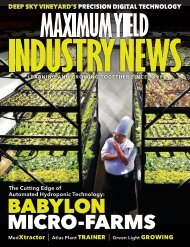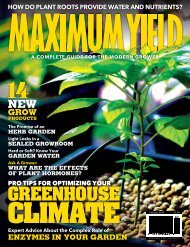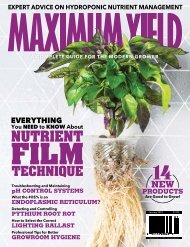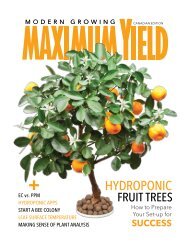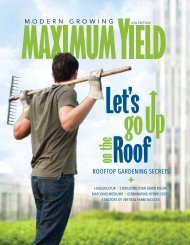Maximum Yield Modern Growing | Canadian Edition | May June 2017
In this issue of Maximum Yield, we cast a wide net to bring you the best and latest information possible to help you get started growing your own food. From the basics like cleaning your equipment to the best methods for preparing your plants to live outdoors, to more advanced topics like lighting and nutrient delivery, there is something in this issue for all levels of grower.
In this issue of Maximum Yield, we cast a wide net to bring you the best and latest information possible to help you get started growing your own food. From the basics like cleaning your equipment to the best methods for preparing your plants to live outdoors, to more advanced topics like lighting and nutrient delivery, there is something in this issue for all levels of grower.
You also want an ePaper? Increase the reach of your titles
YUMPU automatically turns print PDFs into web optimized ePapers that Google loves.
nutrient application systems<br />
Irrigation is a key component of hydroponic gardening and<br />
a common cause of concern for many indoor gardeners.<br />
Fortunately, the technology has come a long way since the<br />
early days of manual watering and gravity-fed systems.<br />
Today, there is a wide range of highly efficient and advanced<br />
nutrient delivery equipment available for even the smallest<br />
grower. Of course, ensuring nutrients flow at the optimal rate,<br />
frequency, and concentration are all dependent on using the<br />
correct delivery system. So, before you begin planting, give<br />
a little consideration to choosing suitable pumps, drippers,<br />
or emitters; matching up the correct irrigation method, and<br />
ensuring even pressure within hydroponic system.<br />
APPLICATION METHODS<br />
Different hydroponic systems employ a diverse range of<br />
nutrient delivery methods. Solution culture systems such as<br />
nutrient film technique (NFT) and deep flow technique (DFT)<br />
may appear to feature the simplest and straightforward<br />
methods of hydroponic nutrient application. Nutrient solution<br />
is continuously pumped to the top of each growing channel<br />
or trough, through which it flows past the roots and back to a<br />
central reservoir. However, factors such as nutrient flow rate,<br />
equalized delivery volumes to each growing channel, and<br />
control over EC and pH back at the reservoir all become part<br />
of the nutrient management system. Similar considerations—<br />
nutrient application frequency and volume—are required with<br />
ebb and flow systems.<br />
Drip irrigation, which is currently the most commonly<br />
used hydroponic nutrient delivery system, relies on even<br />
distribution of solution to each plant at the correct frequency;<br />
factors that are largely based on variables such as plant<br />
size, growing substrate properties, container volume and<br />
dimensions, and environmental conditions.<br />
Aeroponics requires nutrient to be delivered directly<br />
to the root system via the use of high-pressure misters<br />
or foggers, which may be intermittent or continuous.<br />
Overhead sprinklers are also still used in some greenhouse<br />
and outdoor systems, though they are not popular in indoor<br />
gardens due to the leaf wetness and inefficiency of nutrient<br />
distribution. The exception to this may be in propagation<br />
areas where high humidity is beneficial to prevent<br />
desiccation of clones while they form new roots.<br />
All these delivery systems need to be paired with a method<br />
of dosing or controlling the nutrient solution composition<br />
before it is applied to plants. Many indoor gardens are reliant<br />
on manual dosing to reach the correct EC and pH; however,<br />
automation of even small hydroponic systems is becoming<br />
increasingly popular.<br />
Nutrient delivery in a multi-level, movable channel system.<br />
Commercial nutrient dosing and delivery systems may be complex, but<br />
scaled down models are suitable for indoor gardens.<br />
“DRIP IRRIGATION, which is currently the<br />
most commonly used hydroponic nutrient delivery<br />
system, relies on even distribution of solution to<br />
each plant at the correct frequency.”<br />
32 feature




